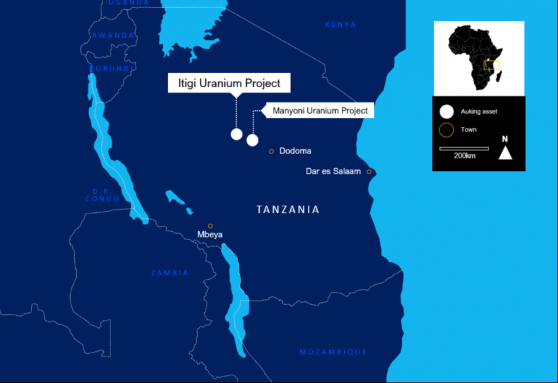AuKing Mining Ltd (ASX:AKN) has launched a 2,000-metre drilling expedition at its Itigi Uranium Project in central Tanzania thanks to a newly minted prospecting licence from the country's Mining Commission.
The explorer will set the drill bit spinning on a considerable radiometric anomaly — spanning 40 kilometres by 10 kilometres — in a bid to put fresh numbers to uranium encountered across more than 400 historical exploration pits.
AuKing CEO Paul Williams is optimistic Itigi's potential could significantly augment the uranium resources at the flagship Manyoni Project, about 80 kilometres east of Itigi.
“Our exploration team recently acquired a substantial amount of historical data from earlier activities at Itigi – none of which has been made publicly available,” he said of the program’s impetus.
“We will also carry out some preliminary XRF measurements on these pits and use that as the basis for assessing samples to be sent for assay.”
Itigi and Manyoni project locations.
History paves the way
More than a decade ago, ASX-listed explorer Uranex (ASX:UNX) announced it had uncovererd an intense radiometric anomaly at Itigi.
At the time, the company said it was the “most intensive and extensive” anomaly it had encountered in all its years in the Manyoni and Bahi region.
“Given its very favourable location, with road and rail access to the Manyoni project area, it has the potential to substantially enhance the development opportunity in the region,” Uranex reported in 2010.
That announcement preceded months of intense exploration, after which the explorer’s focus shifted to other commodities.
However, it wasn’t all for nought: Uranex’s expedition led to nine high-priority targets, 400-plus exploration pits (some with visible uranium) and XRF readings up to 304 parts per million uranium — findings that will chart the course in AuKing’s latest drill program.
All eyes on Itigi
AuKing holds one granted propsecting licence and two licence applications in the Itigi region, all located on the major radiometric anomaly.
AuKing prospecting licences.
With the prospecting licence in hand, the explorer plans to drill over the next two to three months, using aircore and auger techniques to target near-surface uranium upside.
The team plans to expend around A$250,000 over the course of the program.
In addition to drilling, AuKing plans to make preliminary XRF measurements on the uranium-rich pits, giving it some early-stage data as it waits on definitive drilling assays.
The program will keep the company busy as it waits for heavy rainfall to subside in the Manyoni and Mkuju regions, where wet weather has postponed exploration at both sites for several weeks.
Read more on Proactive Investors AU
